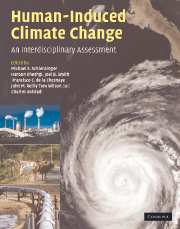Book contents
- Frontmatter
- Contents
- List of contributors
- Preface
- Part I Climate system science
- 1 The concept of climate sensitivity: history and development
- 2 Effect of black carbon on mid-troposphere and surface temperature trends
- 3 Evaluating the impacts of carbonaceous aerosols on clouds and climate
- 4 Probabilistic estimates of climate change: methods, assumptions and examples
- 5 The potential response of historical terrestrial carbon storage to changes in land use, atmospheric CO2, and climate
- 6 The albedo climate impacts of biomass and carbon plantations compared with the CO2 impact
- 7 Overshoot pathways to CO2 stabilization in a multi-gas context
- 8 Effects of air pollution control on climate: results from an integrated global system model
- Part II Impacts and adaptation
- Part III Mitigation of greenhouse gases
- Part IV Policy design and decisionmaking under uncertainty
- Index
- Plate section
- References
8 - Effects of air pollution control on climate: results from an integrated global system model
from Part I - Climate system science
Published online by Cambridge University Press: 06 December 2010
- Frontmatter
- Contents
- List of contributors
- Preface
- Part I Climate system science
- 1 The concept of climate sensitivity: history and development
- 2 Effect of black carbon on mid-troposphere and surface temperature trends
- 3 Evaluating the impacts of carbonaceous aerosols on clouds and climate
- 4 Probabilistic estimates of climate change: methods, assumptions and examples
- 5 The potential response of historical terrestrial carbon storage to changes in land use, atmospheric CO2, and climate
- 6 The albedo climate impacts of biomass and carbon plantations compared with the CO2 impact
- 7 Overshoot pathways to CO2 stabilization in a multi-gas context
- 8 Effects of air pollution control on climate: results from an integrated global system model
- Part II Impacts and adaptation
- Part III Mitigation of greenhouse gases
- Part IV Policy design and decisionmaking under uncertainty
- Index
- Plate section
- References
Summary
Introduction
Urban air pollution has a significant impact on the chemistry of the atmosphere and thus potentially on regional and global climate. Already, air pollution is a major issue in an increasing number of megacities around the world, and new policies to address urban air pollution are likely to be enacted in many developing countries irrespective of the participation of these countries in any explicit future climate policies. The emissions of gases and microscopic particles (aerosols) that are important in air pollution and climate are often highly correlated because of shared generating processes. Most important among these processes is combustion of fossil fuels and biomass which produces carbon dioxide (CO2), carbon monoxide (CO), nitrogen oxides (NOx), volatile organic compounds (VOCs), black carbon (BC) aerosols, and sulfur oxides (SOx, consisting of some sulfate aerosols, but mostly SO2 gas which subsequently forms white sulfate aerosols). In addition, the atmospheric lifecycles of common air pollutants such as CO, NOx, and VOCs, and of the climatically important methane (CH4) and sulfate aerosols, both involve the fast photochemistry of the hydroxyl free radical (OH). Hydroxyl radicals are the dominant “cleansing” chemical in the atmosphere, annually removing about 3.7 gigatonnes (1 GT = 1015 g) of reactive trace gases from the atmosphere; while the environmental impact of each gas is different, this amount is similar to the total mass of carbon removed annually from the atmosphere by the land and ocean combined (Ehhalt, 1999; Prinn, 2003).
- Type
- Chapter
- Information
- Human-Induced Climate ChangeAn Interdisciplinary Assessment, pp. 93 - 102Publisher: Cambridge University PressPrint publication year: 2007
References
- 7
- Cited by



